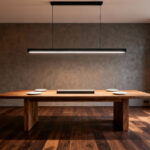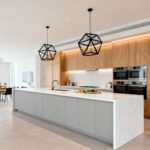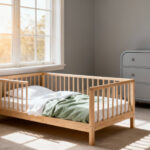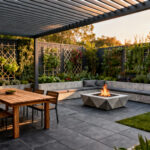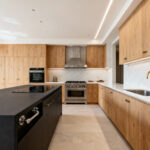You know what people always ask me about kitchen design? It’s not about the trendiest backsplash or what color cabinets are “in” this year. They pull me aside, almost whispering, and ask, “How do I make a kitchen that my mom can use when she visits? That my kids won’t get hurt in? That I can still use in 20 years?” They want a kitchen that looks beautiful, sure, but more than that, they want a kitchen that works for real life. And real life is messy, complicated, and it changes.
This is where everyone else gets it wrong. They sell you on a “look.” I’m here to tell you about a “feel.” It’s the feeling of a space that anticipates your needs, that makes life a little bit easier for everyone who walks through the door, whether they’re 8 or 80, in a wheelchair or on a-ok legs. It’s not a special, clinical-looking “accessible kitchen.” It’s just good design. It’s thinking ahead. So let’s talk about how to build a kitchen that’s not just for today, but for all the tomorrows to come.
Laying the Foundation: Planning Your Dream Kitchen Decor
Forget the showroom perfection for a second. The best kitchens start with honest conversations about how you actually live. This is the bedrock. Planning isn’t about picking out paint chips first; it’s about mapping out a space that will support your family through every stage of life, making every other decision simpler and smarter.
1. Define Your Core Kitchen Decor Style: Modern, Farmhouse, or Traditional?
Honestly, I think these style labels can be a trap. People get so hung up on whether their kitchen is “Modern Farmhouse” or “Organic Modern” that they forget to ask the most important question: “How does this style feel and function?” A high-gloss, ultra-modern kitchen with no handles might look sleek, but for someone with arthritis or limited dexterity, it’s a nightmare to open. A dark, moody traditional kitchen can be beautiful, but it’s a real challenge for anyone with aging eyes or low vision.

So instead of picking a label, let’s talk about qualities. Do you want a kitchen that feels bright and energizing? Look for light colors, reflective surfaces (but matte finishes to reduce glare!), and clean lines. Do you need a space that feels calm and grounded? Think natural wood tones, simple textures, and a clear, uncluttered layout. I once worked with a family whose grandmother was moving in. They loved the “industrial” look but quickly realized that the visual clutter, sharp metal edges, and poor lighting contrast would be disorienting and unsafe for her. We pivoted to a “Warm Minimalist” approach—wood, soft whites, and fantastic lighting. It was still stylish, but it was also kind.
With that mindset, you can start building a space that truly serves you, which flows directly into planning how you’ll move around in it.
2. Prioritize Layout for Workflow Efficiency and Aesthetics.
Everyone loves to talk about the “work triangle”—the path between your fridge, sink, and stove. And sure, it’s a decent starting point. But a home isn’t a commercial kitchen with a single chef. It’s a place where your partner is trying to grab a drink, your kid is doing homework at the counter, and you’re trying to get dinner on the table, all at the same time. The triangle just doesn’t cut it anymore. It’s too rigid and can become a bottleneck.

We need to think in “zones.” You have a prep zone, a cooking zone, a cleanup zone, and maybe a “get out of the cook’s way” zone where someone can grab a snack or pour a coffee without creating a traffic jam. The most critical, and most overlooked, part of this is circulation. Pathways should be at least 42 inches wide, and 48 is even better. This isn’t just for wheelchairs; it’s so two people can pass each other without turning sideways, for carrying a toddler on your hip, for bringing in a load of groceries. Good flow is the invisible luxury that makes a kitchen feel effortless.
This kind of smart, human-centered layout is the key to a kitchen that doesn’t just look good, but feels right, seamlessly connecting it to the rest of your home.
3. Harmonize Kitchen Decor with Your Home’s Overall Design.
This isn’t just about making sure your gray cabinets match your gray sofa. It’s about creating a sense of calm and continuity, which is incredibly important for our brains. When the transition from one room to another is jarring—like stepping from a warm, cozy living room into a sterile, hyper-modern kitchen—it creates a subtle sense of discord. For people with sensory sensitivities, or even just for those of us who feel overwhelmed by a busy day, a cohesive home is a restful home.

The simplest way to achieve this is through consistent flooring. A single, unbroken flooring surface from the kitchen into the main living areas makes the entire space feel larger and more connected. It also eliminates thresholds, which are notorious tripping hazards for everyone, from toddlers to elders. The same goes for color. Carry a few key colors or materials from the living space into the kitchen—maybe the wood tone of your dining table is echoed in open shelves, or a blue accent from a pillow shows up in your backsplash. This isn’t about being matchy-matchy; it’s about creating a gentle, unified story throughout your home.
A home that flows this beautifully deserves a budget that doesn’t cause stress, which is our next crucial step.
4. Establish a Realistic Kitchen Decorating Budget to Guide Choices.
Can we just be honest about budgets? People either skip this step entirely and end up in a panic, or they create one that’s completely disconnected from the reality of what things cost. A realistic budget isn’t a creative straitjacket; it’s a tool that gives you permission to spend money on what actually matters for the long run. And what matters most is creating a space that is safe, comfortable, and functional for decades.

Here’s my shortcut: Divide your budget into “Now” and “Forever” investments. “Forever” items are things that are difficult and expensive to change later: the layout, good lighting, non-slip flooring, and quality cabinets with functional hardware. Spend your money here. Get the full-extension soft-close drawers instead of deep, dark cupboards you have to get on your knees to access. Splurge on the under-cabinet lighting. These are the things that improve your quality of life every single day. The “Now” items are the fun, stylish things that are easier to change: paint color, a trendy backsplash, bar stools, and decorative items. You can save money on these or upgrade them over time as your taste and budget allow.
Once you’ve got a clear financial roadmap, you can confidently return to the mechanics of the layout, starting with that classic rule.
5. Leverage Kitchen Triangle Principles for Optimal Flow.
Okay, let’s revisit that work triangle. While I stand by my belief in “zones” for modern families, the core principle of the triangle—keeping the fridge, sink, and stove in a reasonably close, unobstructed configuration—is still rooted in good ergonomics. It’s about reducing wasted steps and motion, which saves you energy. And for someone dealing with chronic pain, fatigue, or mobility challenges, saving energy is everything.

The key is not to treat the triangle as a rigid, sacred rule, but as a flexible guideline. The total distance between the three points shouldn’t be so vast that you feel like you’re running a marathon, but not so tight that you feel trapped. Most importantly, nothing should block the path. I see so many kitchen islands plopped down right in the middle of the work triangle, forcing you to constantly sidestep and walk around it. That’s bad design, plain and simple. It creates a hazard and an annoyance you’ll live with every single day. A well-placed peninsula or a thoughtfully designed island can support the flow, but a poorly placed one will destroy it.
With the functional flow mapped out, we can finally get to the fun part: picking out the major elements that will bring this space to life.
Key Elements: Major Design Choices & Fixtures
This is where your kitchen gets its personality. But remember, every choice is a chance to make the space work better for everyone. Cabinets, counters, lights—they’re not just background players. They are the primary tools you’ll interact with every day.
6. Choose Cabinet Styles and Finishes to Reflect Your Decor Vision.
The biggest mistake people make with cabinets is choosing them based on a photo in a magazine. What you need to be thinking about is, “What will it be like to use these every single day?” I’m a huge advocate for drawers, drawers, and more drawers in lower cabinets. A deep drawer that pulls all the way out is infinitely more accessible than a fixed shelf in a deep cupboard where things get lost in the back. You don’t have to kneel or bend deeply to get what you need. It’s a game-changer for anyone with a bad back, knee problems, or who uses a wheelchair.

For door styles, simple is often better. Ornate, detailed doors are a pain to keep clean. A simple Shaker or slab-front door is much easier to wipe down. And please, think about hardware. Tiny, slick knobs are tough for anyone with limited grip strength. Consider C-shaped or D-shaped pulls that are easy to grab with a whole hand, not just fingertips. And for visibility, especially for those with low vision, make sure your hardware contrasts with your cabinet color. A dark pull on a light cabinet is a simple, beautiful, and incredibly effective accessibility feature.
Your cabinets set the stage, and the countertops are where the real work happens.
7. Select Countertop Materials for Durability, Style, and Function.
Countertops take a beating, but they also have a huge impact on safety and usability. Everyone loves the look of marble, but I gently steer most people away from it. It’s porous, it stains, it etches if you even look at it with a lemon, and it requires constant sealing. That’s a lot of maintenance. High-gloss, polished surfaces also create a ton of glare, which can be visually fatiguing and particularly difficult for people with vision impairments like cataracts.

Instead, I push for materials like quartz or quartzite in a honed or matte finish. They are incredibly durable, non-porous (so they’re hygienic and easy to clean), and a matte finish dramatically reduces glare. Another huge tip I wish everyone knew: round the edges. A sharp, 90-degree corner on a countertop is a major hazard for a lurching toddler or a person who is unsteady on their feet. A slightly rounded or “eased” edge is a simple detail that makes the whole kitchen safer and more comfortable to move around. And if you’re planning for the long haul, consider varying the counter heights. A section of counter at a lower, 30-inch height is perfect for kids to help out, for rolling out dough, or for someone working from a seated position.
Now that we have our surfaces, let’s make sure we can actually see them properly.
8. Illuminate Your Space with Strategic Kitchen Lighting Design.
If you only splurge on one thing in your kitchen, please let it be lighting. A single overhead light is a recipe for disaster. It casts shadows on your workspace exactly where you’re trying to chop vegetables with a sharp knife. It’s the biggest design crime I see, and it’s so easy to fix. Good lighting isn’t a luxury; it’s a fundamental safety feature. It makes a space feel bigger, cleaner, and more welcoming.

You need to think in layers. First, ambient light, which is your general overhead lighting. Then, the most important layer: task lighting. This means under-cabinet lights that illuminate your counters directly. This is non-negotiable. It eliminates shadows and lets you see what you’re doing. Finally, you can add accent lighting, like a beautiful pendant over an island or sink. Put everything on a dimmer. This allows you to crank up the light for detailed tasks and then soften it for a relaxing dinner. Dimmers let you adjust the space for your needs, your mood, and your eyes as they change over time.
Good lighting shines down on your flooring, which is the unsung hero of a safe and comfortable kitchen.
9. Determine Flooring Options for Durability and Aesthetic Appeal.
kitchen flooring needs to be a workhorse, but a comfortable one. Shiny, polished tile is a slip-and-fall accident waiting to happen, especially when it gets wet. I’ve seen it happen too many times. You want to look for a material with a good “coefficient of friction” rating, which basically means it’s slip-resistant. Matte-finish porcelain tile, luxury vinyl plank (LVP), and marmoleum are all fantastic options.

Also, think about how it feels to stand on. Hard tile can be brutal on your back and joints if you spend a lot of time cooking. Materials like LVP, cork, or rubber have a little more give, making them much more comfortable for long periods of standing. Avoid dramatic patterns or high-contrast tiles, which can be disorienting for people with vision or cognitive impairments, sometimes creating a “visual cliff” effect that makes it look like there’s a step where there isn’t one. A smooth, low-sheen, continuous surface is your best bet for a floor that is both safe and stylish.
Now that the floor is set, let’s think about how our major appliances fit into this puzzle.
10. Integrate Appliances Seamlessly with Built-in or Paneled Designs.
Making appliances “disappear” behind cabinet panels can create a wonderfully calm and uncluttered look. It reduces visual noise, which can be very soothing, especially in open-concept homes. But I’ll be honest—I’m more concerned with the usability of the appliance itself than whether it’s hidden. A beautiful panel-ready dishwasher is useless if it’s so low to the ground that you have to bend in half to load it.

My favorite universal design tricks for appliances?
- Drawer-style dishwashers and microwaves. Placing these at waist-height eliminates so much deep bending and reaching.
- A side-hinge wall oven. Instead of a typical oven door that you have to lean over to access hot dishes (a major burn risk), a side-hinge door lets you get right up close, safely.
- A refrigerator with a bottom freezer drawer. This puts the most frequently accessed items—in the refrigerator section—at a comfortable height for everyone.
Think about the controls, too. Are they easy-to-read digital displays or clunky knobs with tiny print? Choose appliances that are intuitive to use. A well-designed appliance you can use with ease will bring you far more joy than one that’s simply hidden.
With the heavy hitters in place, it’s time to add the layers that make a kitchen feel like your own.
Enhancing Aesthetics: Color, Texture & Personal Touches
This is where the soul of your kitchen comes in. It’s the art, the colors, the little details that tell the story of who lives there. And just like with the big items, these choices can also make the space more functional and welcoming.
11. Implement a Cohesive Kitchen Color Palette for Visual Harmony.
Color isn’t just decoration; it’s a communication tool. Using it wisely can make a kitchen much easier to navigate, especially for someone with low vision. The most important principle is contrast. Your countertops should have a noticeable color and value difference from your flooring. Your cabinets should contrast with your walls. Your light switches and outlets should contrast with the wall they’re on. This isn’t about creating a chaotic, clashing space. It’s about providing clear visual cues that help the brain define edges and objects.

A simple rule of thumb I use is the “grayscale test.” Take a photo of your material samples—your cabinet, counter, floor, and backsplash—and convert it to grayscale. If everything blends into one big blob of medium gray, you don’t have enough contrast. You want to see clear, distinct shades. For instance, a light wood floor, medium-gray cabinets, and a nearly-white countertop provide fantastic visual separation, making the space safer and easier to use while still feeling serene and cohesive.
That principle of contrast is especially vital when we choose a backsplash.
12. Elevate Design with Thoughtful Backsplash Patterns and Materials.
The backsplash is often called the “jewelry” of the kitchen, but it’s also a functional surface that needs to perform. I caution clients against anything too busy or high-contrast in a small pattern. A dizzying mosaic can be visually overwhelming and can even cause vertigo for some people. And anything with deep grout lines or lots of texture is just a magnet for grease and grime, making it hard to clean.

A simple, large-format tile or a solid slab of material (like quartz) is a fantastic choice. It’s incredibly easy to wipe down—a huge plus for anyone with limited energy or mobility. And a smooth, uniform surface contributes to that sense of calm we’re aiming for. If you do want to add a bit of personality with pattern, consider a classic subway tile or a gentle herringbone. And just like with countertops, opt for a matte or satin finish over a high-gloss one to keep glare under control.
Now, let’s add some personality that doesn’t rely on busy tile.
13. Add Decorative Accents and open shelving for Personality.
I have a love-hate relationship with open shelving. From an accessibility standpoint, it can be fantastic. You can see everything at a glance, and items are easy to grab. It’s perfect for frequently used dishes or glasses. But, it can also become a dusty, cluttered mess very quickly, which can be visually stressful and a nightmare for someone with allergies.

My compromise? Use it sparingly and strategically. A few floating shelves near the dishwasher for your everyday plates and bowls is brilliant. It makes unloading a breeze. But don’t replace all your upper cabinets with open shelving unless you truly love dusting. A better way to add personality is to integrate smart, functional decor. A beautiful magnetic knife strip mounted at a safe, accessible height, a wall-mounted rail system for utensils, or a stylish pegboard are all ways to display useful items artfully while freeing up counter and drawer space.
This leads us right into softening up all these hard surfaces.
14. Incorporate Textiles and Soft Furnishings for Comfort and Warmth.
Kitchens are full of hard, reflective surfaces, which can make them noisy, echo-y places. Textiles are the secret weapon to fix this. They absorb sound, add softness, and provide a dose of color and pattern. However, a standard area rug is one of the biggest tripping hazards you can put in a kitchen. It bunches, it slides, it catches on walkers and wheelchairs.

If you want a rug, you must secure it. Use a high-quality non-slip pad and rug tape. Better yet, look into washable, low-pile runner rugs that are designed to stay put. Even better than a rug underfoot are textiles in other places. A simple Roman shade or a fabric valance over the window can do wonders for acoustics and adds a soft touch. Cushions on a banquette or bar stools invite people to sit and stay awhile. Even beautiful, absorbent tea towels hung from an easy-to-reach hook can add that layer of warmth and comfort that makes a kitchen feel like the heart of the home.
Let’s bring that same thoughtful approach to the walls.
15. Maximize Wall Space with Art or Functional Decorative Elements.
Your walls are valuable real estate! Instead of just hanging a random picture, think about how your walls can work for you. This is the perfect place to mount things that you need within easy reach, freeing up precious counter space. I’m talking about things that look good and work hard.

“A well-designed kitchen puts what you need where you need it. Your walls are an untapped resource for making that happen.”
Think about a sleek wall-mounted pot rack for your most-used pans, a magnetic spice rack, or a handsome rail system with hooks for holding utensils. This isn’t just for a professional look; it’s a brilliant accessibility move. It puts essential tools out in the open, at a comfortable height, eliminating the need to rummage through a cluttered drawer. And yes, absolutely leave room for art! Just be strategic. Hang it away from the grease and steam of the stovetop. Choose art that makes you happy and contributes to the calm, welcoming atmosphere you’re building.
All of these aesthetic touches are great, but they fall flat if the kitchen is a disorganized mess.
Optimizing Space & Function: Smart Solutions
This is where good design becomes brilliant. A truly great kitchen isn’t just beautiful on the surface; it has great bones and even better guts. These are the solutions that make you feel like a genius every time you open a cabinet.
16. Optimize Kitchen Storage with Smart Internal Organizers.
This is my absolute favorite part of kitchen design. Smart internal organizers are the single biggest quality-of-life improvement you can make. I’m talking about pull-out pantry shelves that bring the contents of the pantry to you, so you’re not reaching into a dark abyss. I’m talking about corner cabinets with Lazy Susans or articulating pull-outs, so that dead corner becomes prime, accessible storage.

My must-have list for any kitchen I design includes:
- Full-extension, soft-close drawers for all base cabinets.
- Pull-out trash and recycling bins tucked away in a cabinet.
- Vertical dividers for baking sheets and cutting boards, so they’re easy to grab.
- Tiered drawer organizers for spices and utensils.
These aren’t frivolous add-ons; they are fundamental to creating a kitchen that reduces physical strain and frustration. When you can easily see and reach everything you own, you save time, you reduce food waste, and you make the act of cooking more joyful. It’s an investment that pays you back every single day.
Now let’s apply that same smart-thinking to the centerpiece of many kitchens.
17. Integrate Multifunctional Island or Peninsula Designs.
An island can be the command center of a home, but it has to be designed with purpose. The biggest mistake is making it a barrier. As I mentioned before, you need generous pathways—a minimum of 42 inches all around. An island should facilitate flow, not block it. And to be truly universal, it should serve multiple users.

I love designing islands with two different counter heights. A standard 36-inch height for prep work, and a lower, 30-inch table-height section. This lower section is fantastic for so many reasons: it’s a comfortable spot for someone in a wheelchair to work, it’s the perfect height for kids to sit and “help,” and it’s a more ergonomic place for tasks like kneading dough. Make sure there’s clear knee space underneath. An island isn’t just a block of cabinets; it’s a piece of furniture that should invite people to gather around it.
Finally, let’s tackle the clutter that lives on our counters.
18. Conceal Small Appliances with Clever Cabinetry Solutions.
We all have them: the toaster, the coffee maker, the blender. They live on the counter, creating visual clutter and eating up valuable prep space. The solution is an “appliance garage.” This is essentially a dedicated cabinet, often on the countertop, designed to hide these everyday items away. It can have a lift-up door or pocket doors that slide back into the cabinet, so they’re out of the way when you’re using the appliance.

The key to making this work is to plan for it. You absolutely must have electrical outlets installed inside the cabinet. This way, you don’t have to haul the toaster out every morning; you just open the door and use it right there. It’s a simple, elegant solution that instantly makes your kitchen feel cleaner and more spacious. It reduces the visual noise and gives you back your counter space for the things that matter, like preparing a meal for the people you love.
Conclusion
So, you see? A brilliant kitchen isn’t about following a fleeting trend or copying a photo you saw online. It’s about a series of thoughtful, intentional choices that put people first. It’s about building a space that supports you, comforts you, and adapts with you through all of life’s changes. When you prioritize good flow, smart storage, layered lighting, and safe, comfortable materials, you create a kitchen that is inherently beautiful because it is so fundamentally useful.
The magic of this approach—what we call universal design—is that it truly benefits everyone. The features that make a kitchen safer for an aging parent also make it safer for a young child. The drawers that are easier for someone in a wheelchair to access are also more convenient for every single person who uses them. This isn’t about compromise; it’s about a smarter, more empathetic way to design. Your kitchen is the heart of your home. Make it a welcoming one.

